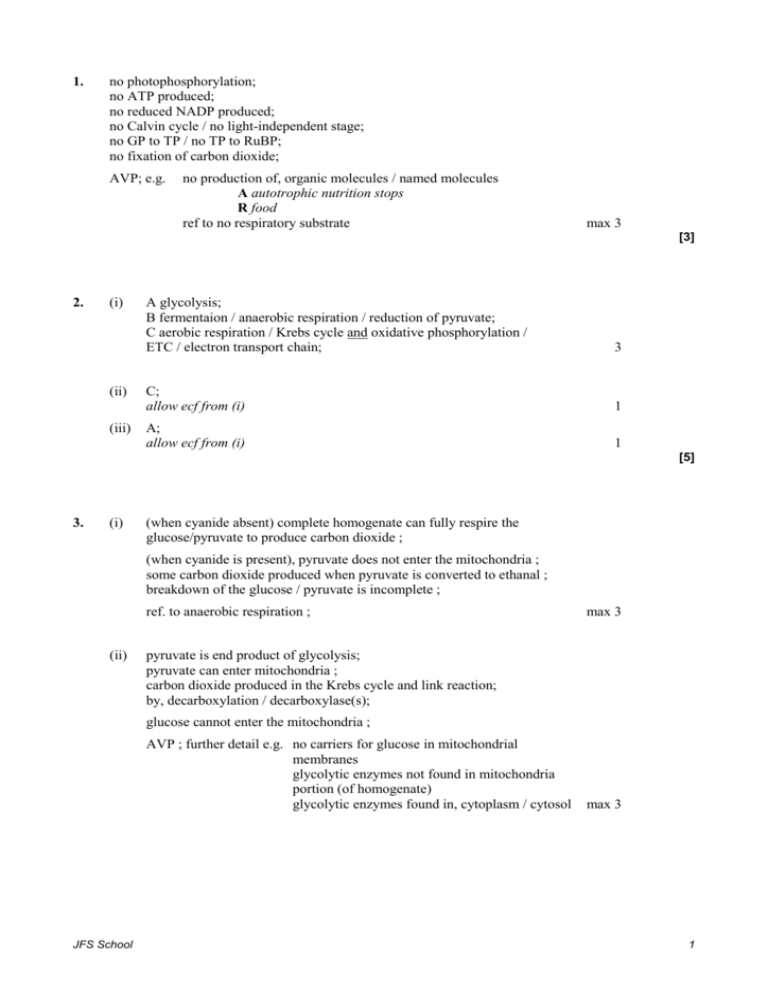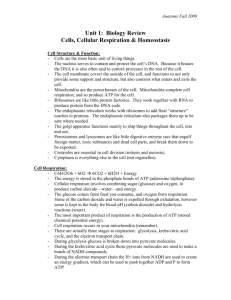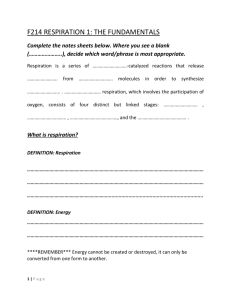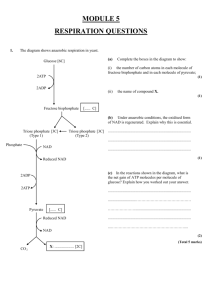F214 Respiration Answers
advertisement

1. no photophosphorylation; no ATP produced; no reduced NADP produced; no Calvin cycle / no light-independent stage; no GP to TP / no TP to RuBP; no fixation of carbon dioxide; AVP; e.g. no production of, organic molecules / named molecules A autotrophic nutrition stops R food ref to no respiratory substrate max 3 [3] 2. (i) (ii) (iii) A glycolysis; B fermentaion / anaerobic respiration / reduction of pyruvate; C aerobic respiration / Krebs cycle and oxidative phosphorylation / ETC / electron transport chain; 3 C; allow ecf from (i) 1 A; allow ecf from (i) 1 [5] 3. (i) (when cyanide absent) complete homogenate can fully respire the glucose/pyruvate to produce carbon dioxide ; (when cyanide is present), pyruvate does not enter the mitochondria ; some carbon dioxide produced when pyruvate is converted to ethanal ; breakdown of the glucose / pyruvate is incomplete ; ref. to anaerobic respiration ; (ii) max 3 pyruvate is end product of glycolysis; pyruvate can enter mitochondria ; carbon dioxide produced in the Krebs cycle and link reaction; by, decarboxylation / decarboxylase(s); glucose cannot enter the mitochondria ; AVP ; further detail e.g. no carriers for glucose in mitochondrial membranes glycolytic enzymes not found in mitochondria portion (of homogenate) glycolytic enzymes found in, cytoplasm / cytosol JFS School max 3 1 (iii) pyruvate is converted to ethanal in cytoplasm ; ethanal is converted to ethanol ; does not involve, cytochromoes / ETC / oxidative phosphorylation; enzymes in cytoplasm not inhibited by cyanide; max 3 [9] 4. (i) (ii) (iii) a biological molecule that can be broken down in respiration to release energy ; 1 award both marks for correct answer 55/77; 0.7 / 0.71; 2 1.0 ; 1 [4] 5. ref. to potassium hydroxide / soda lime; ref. to equilibration / use syringe to set manometer fluid (level); leave for suitable length of time (minimum 20 minutes) and measure distance moved by fluid; repeats and calculate mean; calculate volume of oxygen taken up per minute; AVP; e.g. ref to set-up of control tube (e.g. same mass of beads as of fungus) or (same volume of inert substance as substance A) detail of how to calculate volume of oxygen (by multiplying distance moved by fluid in capillary by 2πr) max 4 [4] 6. (a) (i) (ii) (b) 1; (c) (i) JFS School removal of, carbon dioxide/carboxyl group; removal of hydrogen; R H2/hydrogen molecules/hydrogen ions A H/2H 2 P and Q; 1 1 3; 1; 2 2 (ii) 1 2 3 4 5 6 7 8 9 10 11 (d) inner mitochondrial membrane/cristae; ref to (NADH) dehydrogenase; hydrogen split into protons and electrons; ref to, electron carriers/ETC/cytochromes; energy released from electrons; ref to protons pumped across membrane; protons accumulate in intermembranal space; proton gradient/pH gradient/H+ gradient; protons pass through ATPase; A ATPsynthase/ ATP synthetase/stalked particle ref. to oxygen (final) hydrogen/electron acceptor; formation of water; fats/fatty acids, not respired; ref to (β-)oxidation (of fatty acids) requires NAD; NAD used in breakdown of alcohol; NAD is, limiting/in short supply/AW; fats formed from fatty acids plus glycerol; AVP; e.g. further detail of alcohol/fat metabolism max 4 max 3 [13] 7. (i) releases/source of/provides/to give, energy; for germination; for growth/protein synthesis/spindle formation/organelle replication/ DNA replication/active transport/cell division/other named function; 2 max (ii) higher energy density/release twice as much energy per, g/unit mass; compared to, glucose/protein; 39 kJ g–1; higher proportion of, hydrogen atoms/carbon-hydrogen bonds; advantage for dispersal/named advantage; AVP; e.g. ref to coenzyme A formation 2 max [4] JFS School 3 8. 1 2 3 4 heat loss body/blood, temperature rises; may affect/denature, enzymes/proteins; panting cools body; ref. evaporative cooling; 5 6 7 8 fate of lactate (high) lactate concentration needs to be reduced; due to anaerobic respiration; panting provides extra oxygen/ref. oxygen debt; lactate oxidized to pyruvate; 9 10 11 12 respiratory gases myoglobin would be reoxygenated; haemoglobin would be reoxygenated; ATP/CP, resynthesised in muscle tissue; removal of extra carbon dioxide; 4 max [4] 9. (a) for, flying/hovering/beating wings; muscle activity/AW; ref. ATP/respiration; AVP; e.g. explanation of energy demand of flight small size qualified; e.g. increases heat loss/ ref. large surface area to volume ratio homeothermic qualified; migration qualified; feather growth qualified; e.g. ref. mitosis/protein synthesis (b) (c) JFS School D1 D2 D3 D4 description high(est) incidence of torpor/AW; low(est) oxygen consumption/AW; high(est) body mass/AW; data quote; E1 E2 E3 E4 E5 explanation less food used; (for) less respiration/lower BMR/lower body temperature; more food stored; as fat; (food store/fat) for, migration/flight; max 4 3 max flying, easier/uses less energy (with incomplete feathers if mass low); can, escape predators/find food, (by flying); food used for feather growth; therefore, fat stores used/less food stored; incomplete/missing feathers may reduce body mass; max 4 max 2 4 (d) yes (autumn) high(est) mass birds have low(est) oxygen consumption; (spring) low(est) mass birds have high(est) oxygen consumption; data quote mass plus O2 consumption; only generate heat in proportion to (small) mass; but lose it in proportion to (large) surface area; homeothermic/small birds find it hard to keep warm; max 3 [13] 10. (a) (b) (c) cut/damage, breaks tonoplast/opens vacuole/mixes enzyme and precursor/ AW; enzyme-substrate collisions/AW; (enzyme-substrate complex) releases, smell/volatile chemicals; less precursor chemical; due to, herbivore/fungal/bacterial damage; due to sulphur recycling; due to onion being older; used pyruvate for, link reaction/Krebs cycle/respiration; AVP; (i) (ii) (d) identify mildest/AW; and breed together; detail cross-pollination; idea, repeat/many generations AW; directional selection; AVP; e.g. reference to frequency of alleles grow in low level of, sulphur/sulphate; method of quantifying onion strength/producing extracts of different concentration; method of measuring, rotting/antibiotic effect of onion extract; replicates/mean; ref. control variable or example; ref. fungi/bacteria; AVP; e.g. reference to timescale AVP; e.g. second controlled variable 3 max 2 max 3 1 max 3 [12] JFS School 5 11. accept labelled sketch diagram for marking points below nitrogenous base / purine ; adenine ; pentose / 5 carbon, sugar ; ribose ; three, phosphate groups / Pi ; R phosphate molecule phosphorylated nucleotide ; A adenosine as an alternative to adenine plus ribose 4 max [4] 12. 1 2 3 4 5 6 7 8 9 NAD / FAD, involved in respiration ; associated with, dehydrogenase enzymes / dehydrogenation ; 2 molecules of NAD (reduced) in glycolysis ; link reaction producing 1 molecule of NAD (reduced) ; Krebs cycle produces 3 NAD (reduced) (per turn of cycle) ; detail of any one step in respiration where NAD (reduced) is produced ; Krebs cycle produces 1 FAD (reduced) (per turn of cycle) ; carriers / transfers, hydrogen to, inner mitochondrial membrane / cristae / cytochromes / ETC ; mitochondrial shuttle (bringing NAD reduced from glycolysis into matrix) ; 10 11 12 13 14 15 16 NADP involved in photosynthesis ; produced in non-cyclic (photo)phosphorylation ; hydrogen comes from, water / photolysis ; (used in) Calvin cycle / light independent stage ; GP to TP step ; AVP ; e.g. NADP involved in transporting hydrogen from grana to stroma AVP ; e.g. hydrogen split into electrons and protons at ETC credit annotated diagrams QWC – clear, well organised using specialist terms ; award QWC mark if three of the following are used photophosphorylation cristae glycolysis photolysis Calvin cycle link reaction Krebs cycle dehydrogenase / dehydrogenation 7 max 1 [8] JFS School 6 13. 1 2 3 4 5 6 7 8 9 light absorbed by, pigment / bacteriorhodopsin / protein ; ref to electron carriers / change in shape of bacteriorhodopsin ; energy released from electrons ; R produced / created / made protons into cell wall ; create, proton gradient / electrochemical gradient / pH gradient / proton motive force ; protons, diffuse / move down gradient ; through, ATP synth(et)ase complex / stalked particles ; A ATPase (ATP formed from) ADP + P(i) ; AVP ; e.g. ref to chemiosmosis, ref to energy transducing membrane, ref to redox reactions. 4 max [4] 14. A; C; C; B; [4] 15. ref to oxidative phosphorylation and ATP production ; needs supply of hydrogen ; to form reduced, NAD / FAD ; lipids have more, hydrogen / hydrogen – carbon bonds ; more acetyl coenzyme A generated / more ‘turns’ of Krebs cycle ; 2 max [2] 16. dinitrophenol in body ; ETC still functioning ; less ATP formed in respiration ; food not enough to meet metabolic demands of body / AW ; had to respire, body tissues / food stores ; AVP ; e.g. heat production increasing metabolic rate 3 max [3] 17. (a) (b) (c) JFS School avoid attracting a mate of a different species ; ora ensure reproductive isolation ; (i) diffusion ; (ii) so that they do not receive oxygen constantly ; there are mitochondria between them and the cell surface ; 1 max 1 1 max mitochondria / aerobic respiration / oxidative phosphorylation, inhibited 7 only briefly ; oxygen concentration decreases again ; preventing, action of luciferase / production of light ; each flash short ; ora e.g. so not continuously lit AVP ; (d) active transport ; A e.g. Na+/K+ pump protein synthesis ; synthesis of named substance ; movement of organelles ; phosphorylation of glucose ; AVP ; ; ; e.g. transcription, translation, anabolic reaction R respiration, DNA replication, chromosome movement, mitosis (e) 2 max 3 max cells / membranes, damaged / disrupted ; nitrous oxide released ; mitochondria stop using oxygen ; oxygen, allows light production / reaches light-producing organelles ; in unlimited quantities / continuously, so light is brighter ; respiration / oxidative phosphorylation, ceases ; no more, ATP / NADH2 ; luciferin, synthesis / regeneration, stops ; AVP ; 3 max (f) live bacteria, respire / produce ATP ; ora 1 (g) mRNA (coding for luciferase) ; A DNA 1 [13] JFS School 8 18. (i) palisade (mesophyll) ; spongy (mesophyll) ; mesophyll / chlorenchyma – 1 mark 2 (ii) 1.7, 3.1, 4.0, 4.7, 4.9, 5.0 ; 1 (iii) selection of two temperatures 10 ºC apart ; respiration ref to release of carbon dioxide (in dark is measure of respiration) ; state two figures very close to value of 2, therefore supports ; (all steps in) respiration enzyme catalysed ; (iv) photosynthesis data quotes must be from true rate of photosynthesis only value between 5 ºC and 15 ºC is close ; photosynthesis does not support as (other) values not near 2 ; A data quote to illustrate this / ecf not just enzyme-controlled process / AW ; 4 max light intensity limiting factor ; low rate photosynthesis ; rate respiration increases at higher temperatures ; rate respiration, close to / exceeds, rate of photosynthesis ; A ora net primary productivity is lower / sugars broken down more quickly than formed ; 3 max [10] 19. 1 2 3 4 5 6 7 8 9 10 decomposition / decay / rotting (of grass) ; (microbial) respiration ; (releases) heat ; temperature figures ; uses up oxygen / aerobic ; oxygen figures ; produces carbon dioxide ; carbon dioxide figures ; grass cuttings provide insulation ; AVP ; 5 max [5] JFS School 9 20. (a) 1 2 3 4 5 6 7 8 9 (b) (c) (d) rate of respiration can equal rate of photosynthesis / CO2 used = CO2 produced / O2 used = O2 produced ; ref to compensation point ; mitochondria use oxygen ; chloroplasts produce oxygen ; mitochondria are always active / respiration continues independently of light ; chloroplasts are inactive in dark / photosynthesis does not take place without light ; oxygen released by, chloroplasts / photosynthesis, can be utilised by mitochondria / respiration ; at high light intensities, chloroplasts produce more oxygen than the mitochondria consume ; AVP ; e.g. valid refs to CO2 exchange max 4 phosphate ions are used to produce ATP ; in oxidative phosphorylation / Krebs cycle / chemiosmosis / electron transport / ATP synth(et)ase ; ATP leaves mitochondria ; max 2 carrier protein / transport protein / transmembrane protein involved ; A ref to a specific channel concentration of triose phosphate is higher in the chloroplast (than in the cytoplasm) ; because it is a product of, photosynthesis / light independent reaction / Calvin cycle ; triose phosphate moves, down concentration gradient / from high to low concentration ; ATP not involved / no energy used ; max 2 ignore references to chloroplasts or mitochondria being cells, having cytoplasm and reference to free ribosomes free / naked, DNA ; A DNA not surrounded by, membrane / envelope have an inner folded membrane / AW ; ribosomes, smaller than those in cytosol / similar in size to prokaryotic ribosomes ; A ref to 70S and 80S circular DNA ; A loop AVP ; e.g. absence of introns R absence of a nucleus from the chloroplast or mitochondrion R ref to membranous organelles as chloroplasts and mitochondria are these organelles max 2 [10] JFS School 10 21. S; R; S; A – correct names instead of letters [3] 22. FAD / NAD ; A reduced FAD / reduced NAD / AW [1] JFS School 11








